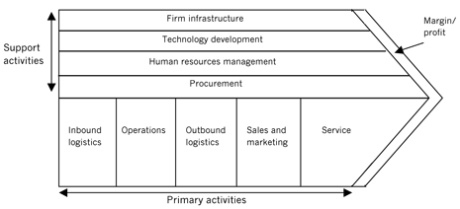ACCA P3 考官文章 BENCHMARKING
Benchmarking can be thought of as a scientific way of setting objectives that will act as targets before and during the operating period, and comparators during and after the period
Benchmarking can be defined as: 'The establishment, by the collection of data, of comparators that allow relative levels of performance to be identified.’
Benchmarking can be thought of as a scientific way of setting objectives that will act as targets before and during the operating period, and comparators during and after the period. The phrase ‘by the collection of data’ is crucial: anyone can establish objectives without the collection of data, but these will be of little use because they are likely to be arbitrary and without any validity. Benchmark data validates objectives.
The sources of data that can be used include internal data (for example, comparing the results of different branches), data about other companies (for example, those in the same industry) and government data (for example, data about employee sick days). We will examine the sources of data in more detail later.
BENCHMARKING AND THE STRATEGIC PLANNING PROCESS
Benchmarking can be used in all three steps of the classical, rational model of strategic planning:
Assess the strategic position (internal and external factors)Frequently, strategic planning starts by defining the mission or mission statement. For example, BMW states that its mission is: ‘The BMW Group is the world’s leading provider of premium products and premium services for individual mobility.’
So, without comparison through benchmarking, how does BMW know that it is delivering premium products and services?
Assessment of an organisation’s current strategic position can be summarised in a SWOT analysis. However, the use of comparators is inherent in a SWOT analysis: if you can say that something is a ‘weakness’ or a ‘strength’ you must be carrying out some sort of comparison when making that value judgement. Similarly with opportunities and threats. A factor is a threat to us only because it is better or stronger than we are in that area – whether it is an organisation that is better financed, or one that produces products more cheaply, or a technological development that promises a better product in terms of cost-benefit, or an organisation that has a stronger brand name.
Note that a benchmarking exercise can also highlight where a competitor’s performance is weaker and so point out the areas where that competitor is vulnerable and might be fruitfully attacked. For example, if it is found that the quality and reliability of a competitor’s products are inferior to one’s own products, then an advertising campaign emphasising quality of our products could be effective.
In all cases, the SWOT analysis should be based as far as possible on facts; data that has been collected and transformed into benchmark standards.
Consider strategies and make choices
Chosen strategies are those that should lead to competitive advantage.
According to Michael Porter, competitive advantage can be obtained through either cost leadership or differentiation (each with or without focus). If cost leadership is to be attained, then an organisation must know what costs it needs to beat. What are competitors’ costs? What are the benchmarks for cost leadership? If the organisation has little hope of equalling or bettering those costs, then cost leadership is not a sensible strategy to attempt.
Similarly with differentiation. This strategy is always more complex than cost leadership, where the main criterion is simply to lower unit costs while maintaining average quality. Differentiation, however, can be attained in a multitude of ways: quality, brand, style, innovation. Whatever the secret of differentiation is, it must be something that beats the competition – better quality, stronger brand attributes, better style or more radical innovation. Once again, measuring how competitors perform in these metrics is essential.
Strategic implementation (strategy into action)
Setting objectives is a major tool for implementing a strategy. Strategic plans are often communicated by issuing budgets to divisions, departments and individuals and, of course, budgets consist of objectives or targets. However, budgets have to be both challenging (to stay competitive and generate motivation) and attainable (to be taken seriously). Once again, an assessment of potential attainability should be based on the results that other organisations achieve, and so budget targets need to be benchmarked against these.
Therefore, benchmarking can be used to:
- push people in the directions where improvement is required
- provide measures as to whether that required performance has been attained or to indicate what improvement is still needed.
TYPES OF BENCHMARK
There are a number of different ways in which benchmarks can be established. A common categorisation of the approaches is as follows:
Internal benchmarking. This does not mean simply inventing an objective internally out of thin air because benchmarking implies comparison. Internal benchmarks are likely to be set by looking at historical performance or performances achieved by different branches or divisions. If last period’s actual results showed that it took 12 minutes to produce each unit, then it might be valid to set a benchmark of 11.5 minutes for the next period. Similarly, if the best branch achieved a net profit percentage of 15%, then that might be a valid target to set all branches.
The potential danger with these approaches is that they are both inward-looking. Therefore:
- No attention has been paid to what other organisations, such as competitors, are achieving. Note that Porter talks of the need to achieve competitive advantage. It’s all very well saying that our best branch achieves 15% net profit, but what if competitors routinely achieve 18%? Similarly, last year’s production time of 12 minutes might be way in excess of more efficient producers.
- Additionally, the opportunities for learning are small. If an organisation does not realise that competitors are better, not only is that dangerous in itself, but the organisation will never be inspired to try to find out how competitors do better.
However, internal benchmarking can have advantages, such as:
- access to the required data should be quick, easy and cheap
- it might be the only method if there are no external suitable companies for comparison
- it might be the only approach possible where other companies’ data is confidential and difficult to obtain.
Industry benchmarking. In this approach, benchmarks are set by looking at what other organisations in the same industry achieve. Industry benchmarking can be divided into:
- non-competitor benchmarking
- competitor benchmarking.
Examples of non-competitor benchmarking can be seen in comparing treatment results for hospitals in different towns, the efficiency of rubbish collection by different local authorities and the exam success of children in different schools. Because the different organisations are not in competition, the exchange of data should be relatively open, though an organisation that thinks it is performing poorly might be reluctant to release its data. Therefore, governments often insist that state enterprises, such as schools or hospitals, publish statistics as it is recognised that this is important information for managers, staff, users of the facilities and government. The hope is that by publishing the data, poorer performers will be motivated to improve their game and to learn from good performers.
Examples of competitor benchmarking can be seen in aircraft turnaround times (how long the aircraft is on the ground between flights) and the load factor (what percentage of seats are occupied) for different airlines. Both of these are relatively easy to measure because they are very visible and you can be sure that airlines keep a close watch on their competitors’ statistics. However, you will appreciate that many of the most interesting pieces of data about a competitor will not be easily accessible and that competitors will often try to keep this information confidential to try to maintain their own competitive advantage. Manufacturing companies sometimes use reverse engineering to attempt to calculate competitors’ costs. It is common, for example, for car companies to buy a competitor’s new model and to dismantle it carefully as the basis for estimating production costs and time.
Although industry benchmarking might seem to be almost foolproof, there is a danger that benchmarks are inappropriate because comparisons are made with the wrong organisation or because no allowance has been made for important differences. Therefore, when comparing the performance of children in schools, it would probably be valid to make allowance for schools in different parts of town. A school in a relatively rich area where many parents are well-educated and supportive of their children might be expected to outperform a school in a poorer area. In addition, an organisation might not be perceived as a competitor (and therefore not used for benchmarking) when in fact it is in competition. For example, there is no point in being a really efficient producer of inexpensive stand-alone digital cameras when that market is being supplanted by the increasing quality of cameras in mobile phones. Similarly, the exercise would be of limited use in comparing the costs of customer interactions in a traditional bank with those of a purely online bank.
Sometimes, organisations in a particular sector set up collaborative benchmarking. Data can be shared either openly (where there is no competition) or anonymously (where there is competition) so that the whole industry can make use of the data to improve. Thus, in the UK each year the Department for Business, Innovation and Skills (a government department) publishes key performance indicator data (around 700 datasets) for the construction industry. Each company will be able to recognise its own data and therefore judge how it is performing relatively.
Best-in-class benchmarking. In this approach, rather than comparing entire organisations, the individual activities of an organisation are compared to those activities in other organisations where the activities are carried out really well. So, it would be valid for a telephone-based bank to compare its call answering times to those in an organisation in a different sector that had a very good reputation in dealing promptly with phone calls. From a pricing perspective, a hotel business might learn a lot from studying how airlines change their fares in response to demand. Both hotel room vacancies and unoccupied aircraft seats are perishable commodities and maximising profits in both industries depends on enticing in the last guest or traveller at the maximum marginal revenue.
One of the most famous examples of best-in-class benchmarking is that of airlines improving their turnaround times by benchmarking themselves against Formula One racing car pit-stop operations. In both cases, there will be both routine operations to be carried out efficiently and occasional emergency or unexpected repairs and replacements of components. Well-trained teams, spares inventories, technician availability will be essential to the success of both operations.
The great strength of best-in-class benchmarking is the high degree of learning that is encouraged. The observation of very successful processes and activities, wherever found, will often generate radical innovation and improvement in an organisation’s competitive strength. Furthermore, very good performance in one aspect of a certain industry, perhaps a very slick website in a travel site, is likely to raise customers’ expectations in many different industries, so that slick websites are expected everywhere.
WHAT SHOULD BE BENCHMARKED?
Priority should be given to benchmarking performance areas that result in an organisation’s success. As mentioned above, an organisation’s success should be defined by its mission, and ambitions stated there should be benchmarked. So, BMW needs to devise measurements that address its mission to make premium products and to deliver premium services, and then must compare its performance to that of companies like Mercedes (same industry) and perhaps to a company such as Amazon for customer service and delivery of spares and accessories.
In profit-seeking organisations competitive advantage can be achieved either by cost leadership or differentiation. If cost leadership is the generic strategy adopted by a supermarket, then the following might be worth benchmarking against competitors:
- Turnover/employment costs
- Shop rent/m2
- Inventory turnover
- Inventory costs
- Wastage
- Number of inventory lines stocked (keep low to minimise costs)
- Gross profit percentage
If, however, the supermarket attempted to compete through differentiation and presented itself as an upmarket brand, then the following might be particularly worth benchmarking:
- Number of inventory lines stocked (keep high to offer choice)
- Number of new products brought to market
- Number of unique products
- Gross profit percentage
- Check-out queuing times
- Customers’ impressions of quality.
Of course, this is not to say that the upmarket supermarket would not care about wastage and so on, but a cost leader lives or dies by keeping costs very low while a differentiator depends on high levels of service, innovation, uniqueness, style and quality.
Another approach that can indicate where benchmarking would be particularly useful is to examine an organisation’s value chain. Porter set this out as follows:

The rationale behind the value chain is that, as a result of an organisation spending time, money and effort carrying out the various activities, the organisation manages to make a profit. In other words, customers are willing to spend more on what the organisation produces than all the activities leading to production actually cost. So the organisation must be doing more than is explicitly depicted on the value chain: this is the value added. For example, because of its size the organisation might have access to economies of scale that are not available to customers. Or the organisation might be using know-how that customers do not possess. Whatever gives rise to the value added is the source of profit and should therefore be benchmarked: poor performance there compared to competitors will eventually lead to declining profits. Therefore, if a supermarket believes that its customers are loyal because it stocks a very wide range of food, then the supermarket should be comparing its range to those in competing supermarkets.
Examination of generic strategies and the value chain shows that benchmarking can be applied to:
- functions (for example, benchmark the cost of running the corporate internet)
- processes (for example, benchmark how long it takes to deal with a customer complaint)
- branches/facilities (for example, benchmark the efficiency of an entire factory)
- strategies (for example, benchmark how our strategy of organic growth for market entry compared to growth by takeover or merger)
- projects (for example, use benchmarking to establish the duration of project activities).
BENCHMARKING METRICS
Once an organisation has decided which aspects of its performance should be benchmarked, it must then establish metrics for those: how can performance be measured?
Some items will be easy to measure. For example, the amount of material used, time taken for producing a unit, turnaround time for aircraft, dispatch time for orders. However, some aspects of performance will be more challenging. For example, flexibility to customer requirements, customer service, and capability of staff. However, difficulty in measurement is no excuse for not attempting to measure and set benchmarks if an element of performance is thought to be important.
After deciding what to measure and how to measure it, data has to be collected that will form the basis of the benchmark. It is important that the data is as accurate and as representative as possible, otherwise the benchmark will be misleading. For example, there might be little point in setting benchmarks during a period of either very low or very high activity as there are likely to be distortions at these extremes. Similarly, although best-in-class benchmarking looks at best performances from different industries, it remains vital to ensure comparability. For example, it is probably unrealistic to benchmark how often a visit to a travel website results in a sale against the sales rates obtained by a website that sells low-value consumer goods. Consumers are likely to make several visits to a website when they are buying high-value goods before they make up their minds; cheap purchases are likely to be bought more on impulse.
POTENTIAL PROBLEMS WITH BENCHMARKING
As explained above, there is always a danger that a benchmark might not be appropriate. Even if set correctly initially, there is a risk that it is not updated so that organisations become complacent and aim at the wrong things.
Benchmarking does not itself explain why an organisation might not be performing properly. The whole exercise is rather pointless if efforts are not made to understand the causes of an organisation’s shortcomings. Instead of using benchmarking as a push towards improvement, and finding out how good companies achieve high performance, managers can sometimes become defensive and begin to defend their performance by attacking the credibility of the target.
Whatever is measured is changed. Employees know that whenever performance targets or objectives are set, then almost certainly appraisal will follow. Therefore, full attention is paid to whatever is measured, often to the detriment of overall desirable performance. For example, in the UK National Health Service, governments are very sensitive to accusations that patient waiting lists are too long. Benchmarks for hospitals are then issued. Even where these have been properly established, they can distort the healthcare provided by hospitals. For example, a way to quickly and cheaply reduce waiting lists in orthopaedic departments could be to carry out lots of relatively quick simple operations and to relegate seriously ill patients who need more time-consuming surgery.
Ken Garrett is a freelance lecturer and writer
温馨提示:2016年新考季,泽稷网校ACCA名师为大家准备了2016 ACCA学习资料大礼包(内含ACCA历年真题、考官文章、考官报告、备考宝典等实用学习资料),关注微信公众号:ACCA考友论坛(ID:ACCA-CHN)即可领取:






 白金级认可培训资质(总部)
白金级认可培训资质(总部)
 课程试听
课程试听
 职业规划
职业规划
 ACCA中文教材
ACCA中文教材
 考位预约
考位预约
 免费资料
免费资料




 题库下载
题库下载
 模拟机考
模拟机考




 CFA®成绩查询
CFA®成绩查询




 GARP协会官方认可FRM®备考机构
GARP协会官方认可FRM®备考机构




















